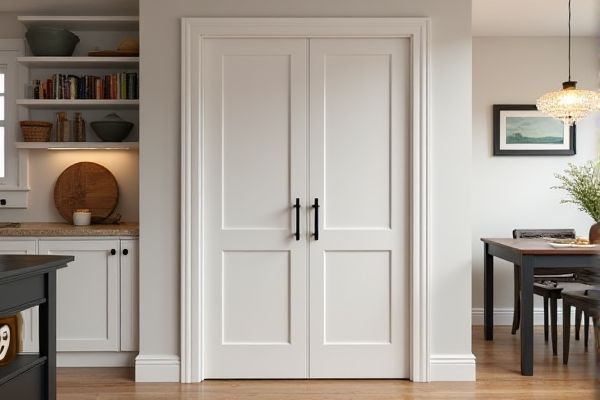
Bifold pantry doors offer space-saving functionality by folding neatly to one side, making them ideal for compact kitchens, while sliding pantry doors glide smoothly along a track, providing easy access without obstructing adjacent spaces. Discover which option best fits your kitchen design and lifestyle by reading the rest of the article.
Table of Comparison
| Feature | Bifold Pantry Door | Sliding Pantry Door |
|---|---|---|
| Space Efficiency | Folds inward, requires clearance space | Slides along wall, ideal for tight spaces |
| Installation | Moderate complexity, requires hinges and track | Moderate complexity, requires track system |
| Accessibility | Full access when open | Partial access, one side visible at a time |
| Design Styles | Traditional and modern panels | Contemporary, minimalist, or rustic |
| Durability | Hinges prone to wear | Track and rollers require maintenance |
| Cost | Usually lower cost | Typically higher cost |
| Noise Level | Quiet operation | Sliding may produce noise on track |
Introduction to Pantry Door Options
Bifold pantry doors consist of two panels hinged together, offering space-saving functionality crucial for compact kitchens by folding neatly to one side. Sliding pantry doors glide along a track, maximizing floor space without interruption, ideal for open areas or narrow corridors. Choosing between bifold and sliding doors depends on kitchen layout, available space, and ease of access preferences.
Overview of Bifold Pantry Doors
Bifold pantry doors consist of two panels hinged together that fold to one side, maximizing space efficiency in kitchens with limited room for door swing. These doors offer easy access to the entire pantry by fully opening the doorway without obstructing adjacent cabinets or appliances. Crafted from materials like wood, MDF, or glass, bifold doors blend functionality with aesthetic flexibility in modern kitchen designs.
Overview of Sliding Pantry Doors
Sliding pantry doors save space by gliding smoothly along a track, making them ideal for kitchens with limited room. These doors offer easy access to your pantry without obstructing adjacent areas, enhancing both functionality and style. Their modern design complements various kitchen decors while maximizing storage efficiency.
Space-Saving Benefits Compared
Bifold pantry doors fold inwards, taking up minimal swing space and making them ideal for tight kitchens where every inch counts. Sliding pantry doors glide along a track parallel to the wall, completely eliminating door swing and freeing up surrounding space for other uses. Your choice between these options should consider the available clearance and how you prioritize ease of access versus maximizing floor area.
Installation Process: Bifold vs Sliding
Installing a bifold pantry door involves mounting hinges on the door panels and securing a track at the top and possibly the bottom of the door frame to allow the panels to fold smoothly. Sliding pantry door installation requires installing a wall-mounted or recessed track above the pantry opening, enabling the door to slide horizontally without occupying additional space inside the kitchen. Your choice between bifold and sliding pantry doors depends on wall space availability and the ease of accessing pantry contents with each door mechanism.
Aesthetic Appeal and Design Flexibility
Bifold pantry doors offer a classic, segmented look that enhances traditional or rustic kitchen designs, allowing for full access to the pantry without obstructing nearby space. Sliding pantry doors provide a sleek, modern aesthetic with clean lines and can be customized with various materials and finishes, making them ideal for contemporary kitchens with limited floor space. Your choice between these options should consider the overall kitchen style and space constraints to maximize both aesthetic appeal and functional design flexibility.
Durability and Maintenance Needs
Bifold pantry doors typically feature sturdy hinges but may require frequent adjustments to prevent misalignment, impacting long-term durability. Sliding pantry doors, often equipped with robust tracks and rollers, offer smoother operation and generally demand less maintenance while resisting wear from constant use. Choosing the right door depends on your preference for ease of upkeep and the specific durability requirements of your pantry space.
Accessibility and Ease of Use
Bifold pantry doors offer wide access by folding completely to the side, allowing your entire pantry to be visible and reachable at once, improving organization and convenience. Sliding pantry doors save space by gliding smoothly along a track without swinging out, which is ideal for tight kitchen layouts where clearance is limited. Your choice depends on prioritizing maximum accessibility with bifold doors or compact efficiency with sliding doors.
Cost Comparison: Bifold vs Sliding Doors
Bifold pantry doors generally cost less upfront due to simpler hardware and installation compared to sliding pantry doors, which often require more complex tracks and rollers. Sliding doors tend to have higher maintenance costs over time because of their mechanisms that can wear out or misalign. For long-term budgeting, bifold doors offer a more cost-effective solution while sliding doors provide a sleek aesthetic with a higher initial investment.
Choosing the Best Pantry Door for Your Space
Bifold pantry doors optimize space by folding neatly, ideal for narrow kitchens or tight corners where door swing is limited. Sliding pantry doors save room by gliding horizontally along a track, perfect for kitchens needing unobstructed access without door interference. Assessing kitchen layout, available clearance, and ease of access helps determine whether a bifold or sliding pantry door best fits your functional and aesthetic needs.
 homyna.com
homyna.com